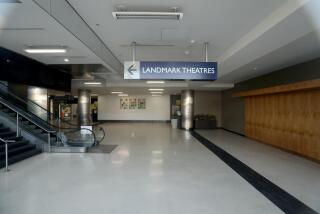Eco Centering
- Share via
In Glendale, they’ve got it ecologically all together.
The city’s one-stop Environmental Management Center, which opened last week at 780 Flower St., includes a hazardous-waste collection center where residents may dispose of toxic materials, a buy-back center where residents get market value for recyclables and an environmental consumer center that provides information on water and energy conservation, drought-tolerant landscaping, fire prevention and other environmental issues.
The head man at the center is Christopher Gray, a Glendale battalion chief and fire marshal who has been working on the project for five years.
“The city asked the Fire Department to develop a system for collection of toxic materials in 1986,” Gray said.
“At that time, we just wanted to develop a way of collecting these dangerous substances in order to protect our environment, protect our sanitation people, who have been burned by these materials.”
In 1987, Gray, who has an engineering degree from UCLA, helped organize the city’s first toxic materials collection. He said thousands of people brought in containers with battery acid, paint, paint thinner, motor oil, photo and swimming pool chemicals, pesticides, rust removers and other inflammable or environmentally hazardous materials.
Two things became clear to Gray and other city officials at that point.
“We began to see that we couldn’t go at the overall problem piecemeal. Ecology is about the interrelatedness of nature and the effect our actions have on it,” he said. “The second thing was that it was pretty clear that, just like the ‘70s and ‘80s, when the Fire Department got into emergency medicine in a major way, during the ‘90s, it would be the environment.”
With the support and guidance of the City Council and City Manager Dave Ramsey, Gray began to envision the kind of information and support that would be necessary to serve area residents, which is how the center came into being. The center is, according to Gray, one of the first facilities in the country to provide residents with a full program of environmental services.
“We got the use of some good-sized adjoining city properties on which to create the center, and we got the help and input of many governmental and private sector groups, like the League of Women Voters,” Gray said.
He said the center will continue to update its information and create new and bigger displays.
All this is good news to the residents of Glendale.
The bad news is it’s for locals only.
Flight of Fancy
After more than 15 years of a “y’all come” policy, the National Aeronautics and Space Administration has finally had to ask visitors to its Flight Research Facility in Rosamond to call ahead.
“Sometimes we would have more than 100 people on the morning or afternoon tours,” Public Information Officer Don Haley said, “and that was just too many bodies.”
Now, he said, to take the 90-minute tour given at 10:15 a.m. or 1:15 p.m. Mondays through Fridays, one must make a reservation at least a day in advance.
The tour includes a showing of the film “Reaching for Tomorrow,” which explores NASA’s history and accomplishments, and then a lot of NASA hardware, including craft from the past and present--such as an X-1, the experimental rocket that Chuck Yeager flew; the X-29, with its forward-swept wings, and the B-52 that has been adapted for midair launching of the Pegasus space rocket.
Either before or after the tour, everyone seems to head to the cafeteria, and the attraction there is not necessarily the food. “You don’t really know when you will be sitting next to a test pilot or an astronaut,” said tour guide Jo Lynn Garlow, who is married to a flight test navigator.
The big item in the center’s gift shop is astronaut ice cream, a freeze-dried food developed by scientists to be taken into space.
“It tastes like Styrofoam when you first put it in your mouth,” Garlow said. “But then it melts and tastes like the real thing.
“Sort of.”
Uprooting
Mary Corcoran, who has a Ph.D. in biology, has spent most of her 30-year professional career studying plants or explaining them to students at Cal State Northridge.
Now, all of a sudden, she has been uprooted from her studious pursuits to chair the biology department, which had been headed by Warren Furumoto. It’s been something of a culture shock.
“When I first heard that Warren Furumoto would become the acting associate vice president for academic service, I thought I would have until next September to get acquainted with the idea of the chairmanship as well as the duties.”
This was not to be.
“He assumed the new position almost immediately and that meant that I had to fill the chairmanship with almost no notice at all,” she said.
She got colleagues to take some of her classes and to fill in as the school of biology graduate coordinator. Then she just waded into the administrative mainstream.
In some ways, it was like being a stranger in a strange land, she said, and she’s had some experience with that before.
In the mid-’60s, her engineer husband was posted to Iran, and she packed up their belongings and 10-month-old son and joined him.
“It was during the shah’s regime,” she said, “so they were still friendly to Americans, but there were some challenges.”
One challenge was the milk.
“It was delivered in bottles by a non-refrigerated donkey,” Corcoran said with a laugh. “You had to drink it fast and hope for the best.”
Overheard
“The way most celebrity divorces are going these days, you’d think the marriage vows were ‘For bitter, or worse.’ ”
--Woman at ladies’ lunch in Studio City


